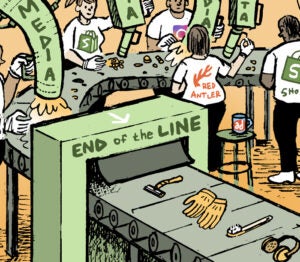“Data-Driven Thinking” is written by members of the media community and contains fresh ideas on the digital revolution in media.
Today’s column is written by Brian Chap, founder of Tech Recipes.
In-housing enables programmatic media buying automation, but that automation doesn’t mean simplification. Brands still need operating models that hold themselves, and all of their affiliates accountable.
Sadly, agencies don’t always practice daily optimization resulting in performance loss. Programmatic requires ongoing maintenance, proactivity and creative thinking to make the best use of brand investment.
In this article we are going to go beyond the benefits of in-housing and dig into some watch outs when considering an in-house model. As you embark on your digital transformation journey, there are four main complexities to be aware of.
Before we begin, a word of caution: The world of data is changing, with the deprecation of third-party cookies and restrictions on identifiers. Today’s world involves cookies, whereas tomorrow’s world involves an as-yet-defined unique ID solution.
This article focuses on today’s world.
So while these solutions exist today, you as a marketer must understand what’s happening tomorrow – and if you’re going to invest a lot of money on in-housing, you also need to consider how to future proof it.
The nuances of the technology
The first step of a successful in-house strategy is owning technology contracts. By doing so, you promote the highest transparency and limit the potential agency rebate programs. At a minimum, brands should prioritize the following technology:
- Ad Server: Sends the creative to the advertising placement and tracks performance
- DSP: Automates media buying and manages real-time optimization
- DMP/CDP: Consumer data collection, insight and activation
As brand advertising stacks grow, strict evaluation criteria should always be exercised or compatibility challenges may arise. To avoid a situation where you invest in incompatible or ineffective technology, be sure to ask these questions:
- What are your differentiators, and who are your competitors?
- Do you have integrations with any other tech partners?
- If not, can you create them?
The amount of people you need to organize
In-housing can require stakeholder alignment in Media, Finance, Marketing, Procurement and IT. Add brand marketers, technology resource and agency counterparts, and teams grow to 90 people. Without staffing expertise, brands will manage too many people resulting in ineffective collaboration and inflated costs.
How to manage the new data
First-party data is almost always supplemented with second- or third-party data. Based on our own studies, we’ve found that on average, agencies waste 30% of brand investments, 15% of which usually overlaps with first-party data. Without knowledge, control and transparency, brands will lose out on stronger ROI outcomes.
Broadly speaking, here are the general steps you need toward getting control of your data.
Brands that already own their data collection can now make sense of what’s stored. Through audience segmentation you can understand your true consumer with data-informed insight and merge those insights with media to create personalized experiences that move your consumer down the funnel.
For brands who rely on agencies, it’s always recommended to confirm data portability. Once brands establish a DMP/CDP, the agency can transfer existing data to the new storage facility creating more control and transparency.
Advanced brands might consider bypassing DMP/CDP software altogether and focus on building an identity graph. An identity graph is a custom methodology, created for a brand, that houses and can action against all the known identifiers (age, sex, browsing behavior, etc.) across all business systems (CRM, email, ecommerce, social, etc.) to correlate data-based insight with individual customers.
This graph is complex and can require significant resources to complete. You can reduce non-working costs by investing in project-based completion with third-party experts, which can cost at least $125,000.
Once completed, this graph can be brought in house for ongoing maintenance to connect directly to a media source and understand the audience match prior to purchasing media. This strategy builds a cohesive, omnichannel view of your consumers, so you can reach them when and where they are most likely to engage along the sales funnel.
A successful ID Graph should help marketers continuously enrich, update and share identity data across the entire organization to facilitate greater control and personalization; create a single, holistic view that accurately measures customer sales across all channels; and help the marketer spend less for better results.
More skills to ramp up
Programmatic marketing requires different talent including buyers, planners, technology experts, measurement managers and analysts who understand data and provide actionable insight.
Trainings, in collaboration with brand stakeholders, are necessary to fill gaps. “Train-the-trainer” is a module used to waterfall the information needed to adopt new operating models, and it is an invaluable framework that identifies internal talent who can contribute to onboarding. Ultimately, attendees learn the skills to instruct others.
Accountability for all
When an organization commits to digital transformation, it must also reinvent employee sourcing to secure exceptional talent. Brands are competing with other marketers as well as with the ad tech behemoths such as Google, Facebook and Amazon.
HR departments at brands are used for hiring marketers, not programmatic, tech or even marketing tech experts. If you let your HR department source and hire without being trained on programmatic requirements, you’ll end up with the wrong talent. To alleviate this risk, organizations must be educated to understand what sort of talent is needed, and trained to communicate the brand’s value proposition used to entice talent that might otherwise go to Google, Facebook or Amazon.
Then brands must figure out the appropriate retention strategy to keep that talent.
Once you determine how to find and keep the right talent, you also must create the appropriate workflow to ensure that your talent, whether it be internal or external, remains accountable. This process means having the right structures in place.
Consider that a typical marketing budget forecast is broken out by vertical. Within media, there will be TV, print, radio, digital, etc. In this new world of in-housing, everything merges, so budget models must be reinvented to ensure accountability and accurate reconciliation.
For example, a brand could hire a programmatic lead to oversee global efforts but if there’s no way to plan and reconcile, centralization of omnichannel allocation will prove challenging.
More to come
Next month, we’ll dive deeper into how brands should think about in-housing organizational structure by providing staffing, billing and infrastructure knowledge to support your digital transformation journey.
Follow Brian Chap on LinkedIn and AdExchanger (@adexchanger) on Twitter.













